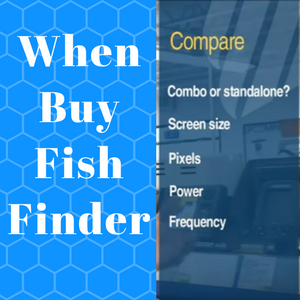Last updated on February 10th, 2024
Getting lost in flashers, echoes, transducers, transom mounts, and sonar is quite easy which is why most people forget the things to consider when buying a fish finder. This is an extremely effective fishing gadget to help you see fish and the structure underneath the water you never knew existed. However, a single misstep when it comes to finding an appropriate fish finder can make your fishing a waste of time.
The advance in sonar technology has been phenomenal and manufacturers have stepped up their game to create the best fish finders in the market. However, some haven’t changed to the latest trends. This is why you need some guidelines when it comes to choosing a fish finder. So if you are asking what fish finder is most appropriate, here is what you should look at.
Frequencies
The frequency of the fish finder will determine whether it is appropriate or not. Most of the dual-frequency transducers come with both 20 and 60-degree cones. Others will come with either 50, 83, 192, or 200 kHz frequencies in a direction to the cone angle.
However, a suitable finder for shallow water has higher frequencies such as 192 and 200 kHz. The lower transducers, on the other hand, will work best in deep waters with low frequencies like 50 kHz.
These are usually used by professionals or for commercial use. It is important to understand that the higher the frequency, the more details you will see on the screen.
If you want more details than any other fishfinder then go for one that offers a whopping 400 kHz or more frequencies. Such will show you detailed images and also allow you to switch between them with ease and more general views.
It is important to understand that the higher the frequency, the more details you will see on the screen. If you want more details than any other fishfinder then go for one that offers a whopping 400 kHz or more frequencies. Such will show you detailed images and also allow you to switch between them with ease and more general views.
Screen resolution
If you are also wondering what fish finder is most appropriate, consider the screen resolution. This is normally determined by the number of pixels the screen of your fish finder displays.
In layman’s, a pixel is that single dot on your screen. The dot is simply the smallest amount of detail you see on your screen. So when the dots are put together, what you ultimately see are images or figures.
So if you have a 640 x 640 pixels screen then you will have 640 dots In each row from right to left. This also means that 640 dots run up to down.
An appropriate fish finder has a greater number of pixels. This means that you will be able to see more details. So the minimum you want is a 240(v) x 160(h) pixel fish finder.
How To Choose Fish Finder video guide
[amazon bestseller=” Fish Finder Is Most Appropriate To Catch” items=”5″ template=”table”]





